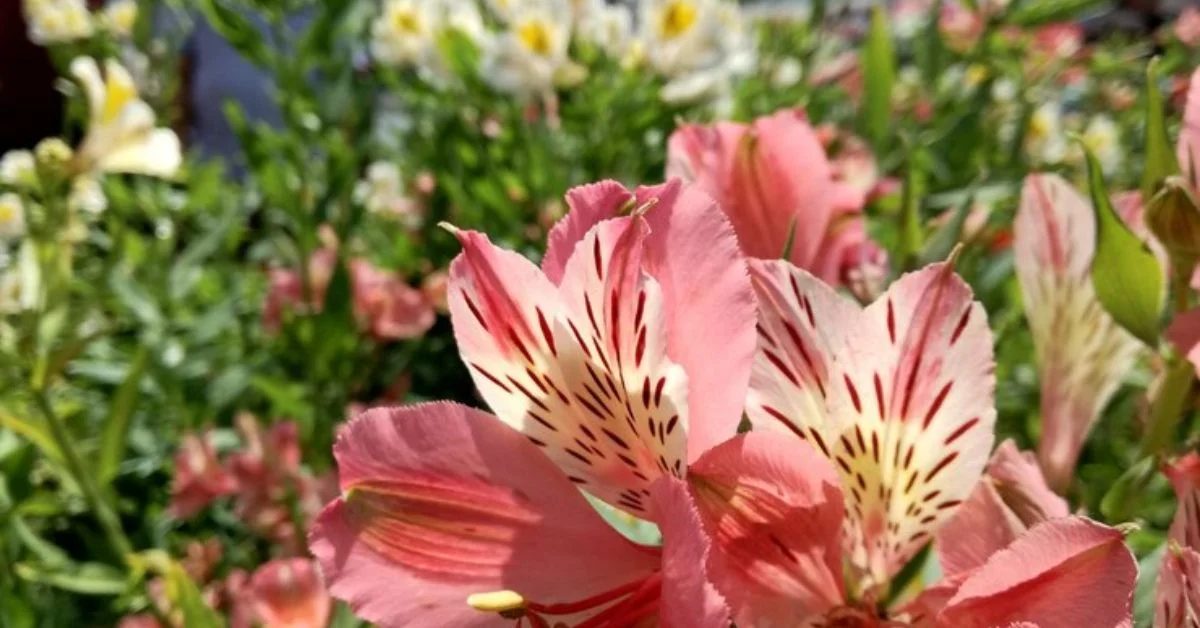In a world where botanical trends shift with cultural tastes, climate patterns, and interior design philosophies, some flowers manage to remain perennially relevant. One such bloom is the Alstroemeria, often affectionately called the Peruvian lily or lily of the Incas. It’s not only a staple in florists’ arrangements across continents but also a surprisingly hardy garden flower that reflects beauty, diversity, and resilience.
Alstroemeria is a genus of flowering plants native to South America, particularly Chile and Brazil. Characterized by its vivid colors, freckled petals, and long-lasting blooms, it has become a favorite in global horticulture, thanks to its ornamental appeal, versatility in arrangements, and its symbolism of friendship and devotion. Over the years, Alstroemeria has moved beyond its native terrain to thrive in gardens and vases from North America to Europe, from Asia to Australia.
This article provides a detailed and informative overview of Alstroemeria—covering its origins, botanical features, care requirements, cultural significance, propagation methods, and evolving role in today’s floral and landscaping industries.
The Botanical Identity of Alstroemeria
Alstroemeria belongs to the family Alstroemeriaceae, and its genus includes over 50 species. These are herbaceous perennials, which means they live for multiple years, typically dying back in winter and re-emerging each spring.
Key Characteristics:
- Growth Habit: Grows in clumps, with tuberous roots and slender, often zigzag stems.
- Leaves: Alternate and narrow, with a unique feature called resupination—they twist as they grow, so the underside faces up.
- Flowers: The blooms are trumpet-shaped, with six petals, often speckled or streaked, and come in shades of white, pink, orange, red, yellow, and purple.
What makes Alstroemeria especially unique is not just its floral appearance, but the fact that it lasts unusually long in cut arrangements—sometimes up to two weeks with proper care.
Origins: From the Andes to the World
Alstroemeria is native to South America, particularly the coastal and mountainous regions of Chile and Brazil. There are two primary ecotypes:
- Chilean varieties (winter-growing species): Adapted to cooler climates and seasonal rainfall.
- Brazilian varieties (summer-growing species): Thrive in tropical and subtropical climates.
The plant was first catalogued in the 18th century by Baron Clas Alströmer, a Swedish botanist and student of Carl Linnaeus, which is how the genus got its name.
By the late 20th century, Alstroemeria hybrids had entered global commercial horticulture, where breeders began developing cultivars with more vibrant colors, sturdier stems, and broader environmental tolerance.
Cultivation: How to Grow Alstroemeria Successfully
Despite its exotic origins, Alstroemeria is relatively easy to grow with the right conditions. Here’s a breakdown of what it requires:
1. Climate
- Best suited for USDA zones 6–10.
- Can tolerate frost with mulch protection.
- Prefers mild summers; extreme heat may reduce flowering.
2. Soil
- Well-draining soil is critical.
- Loamy or sandy soil with neutral to slightly acidic pH works best.
- Avoid waterlogged soils—tubers are prone to rot.
3. Sunlight
- Full sun in cooler climates; partial shade in hotter zones.
- At least 6 hours of sunlight encourages best flowering.
4. Watering
- Regular watering during growing season.
- Reduce watering after flowering ends in late summer or early autumn.
5. Fertilization
- Balanced liquid fertilizer every 2–3 weeks during bloom season.
- Avoid over-fertilizing with nitrogen—it can reduce flower output.
6. Propagation
- Best done through division of rhizomes or tubers every 2–3 years.
- Can also be grown from seed, but this is slow and may not preserve hybrid traits.
7. Pest and Disease Management
- Susceptible to slugs, snails, and aphids.
- Fungal root rot is the biggest threat—ensure soil drainage.
- Use neem oil or horticultural soap for minor infestations.
In the Garden: Design and Companion Planting
Alstroemeria serves multiple roles in landscaping:
- Border and edging plant: Provides continuous blooms from late spring through summer.
- Container gardening: Ideal for patios with sufficient sun exposure.
- Cut flower gardens: Grows well alongside dahlias, lilies, and rudbeckia.
Ideal Companions:
- Salvia (for pollinators)
- Lavender (for contrast and aroma)
- Coreopsis (synchronized bloom cycles)
- Ferns (for partial-shade gardens)
Their upright habit and showy flowers also make Alstroemeria a good choice for formal beds or color-themed gardens.
Alstroemeria in Floral Design and Commerce
Today, Alstroemeria is a cornerstone of the global cut-flower industry. Its popularity stems from:
- Longevity in vases (10–14 days average).
- Diverse color palette for mix-and-match designs.
- Strong stems that support elaborate bouquets.
- Symbolic value—ideal for birthdays, weddings, and friendship celebrations.
It is especially prominent in European and North American flower markets, where Dutch growers lead in commercial production. In the U.S., California and Oregon are key growing regions.
Florists appreciate its affordability, availability year-round, and versatility—it pairs beautifully with roses, chrysanthemums, snapdragons, and greens like eucalyptus and ruscus.
Symbolism and Cultural Meaning
While roses represent romantic love and lilies signify purity, Alstroemeria stands for friendship, mutual support, and long-lasting bonds. It’s often gifted:
- To mark milestone anniversaries.
- As a thank-you flower.
- During friendship celebrations.
- For graduations or farewells, symbolizing ongoing support.
In South America, it also carries regional pride, especially in Chile, where native species grow in wild meadows and highland forests.
Its twisted leaves are sometimes seen as a metaphor for the unpredictable paths in human relationships, further reinforcing its emotional symbolism.
Challenges and Myths About Growing Alstroemeria
Despite its adaptability, Alstroemeria is surrounded by several myths:
Myth 1: It’s too delicate for home gardens.
Reality: Once established, it’s resilient and low-maintenance.
Myth 2: It only grows in greenhouses.
Reality: While common in commercial greenhouses, many cultivars are ideal for outdoor beds or containers.
Myth 3: Alstroemeria needs rich, fertilized soil.
Reality: Overfeeding leads to excessive leaves and fewer flowers. Moderation is key.
Myth 4: You should cut the flowers with scissors.
Reality: Tugging gently from the base encourages new growth better than cutting stems.
These misunderstandings often discourage novice gardeners, but those who persist are rewarded with seasons of vibrant, elegant blooms.
Sustainability and Environmental Impact
As with many globally traded flowers, Alstroemeria’s cultivation has raised sustainability concerns—mostly centered around water usage, chemical pesticides, and carbon emissions from transport.
However, several practices are changing that:
- Drip irrigation systems for water conservation.
- Biological pest control using predatory insects.
- Local sourcing through regional growers to reduce flower miles.
- Certifications like Florverde or Rainforest Alliance ensuring ethical labor and environmental standards.
These shifts reflect a growing consumer interest in eco-conscious floriculture, where Alstroemeria continues to be a popular yet evolving choice.
The Future of Alstroemeria in Horticulture
Innovation in the plant world often mirrors societal desires: longer bloom times, unique colors, and climate adaptability. With Alstroemeria:
- Breeders are developing dwarf cultivars for balconies and indoor pots.
- Heat-tolerant hybrids are expanding its range into warmer regions.
- Biotech experiments are exploring gene editing to create pest-resistant strains.
As demand continues in both retail and landscaping sectors, Alstroemeria is poised to remain a mainstay of modern gardens and greenhouses alike.
Conclusion: Why Alstroemeria Still Matters
In an age where novelty drives much of consumer preference, Alstroemeria stands out as a classic flower that has quietly adapted and thrived. It’s easy to grow, hard to kill, and elegant in almost any context—qualities that have kept it relevant in a crowded floral landscape.
Its meaning of enduring friendship, its tenacity in harsh conditions, and its ability to light up a room without overwhelming it, make it a symbol of both natural resilience and human connection. Whether in a bouquet, a backyard garden, or a florist’s cooler, Alstroemeria is more than decoration. It is a reminder of beauty that lasts—not just for days, but for years, seasons, and friendships.
Frequently Asked Questions (FAQs)
1. What is Alstroemeria commonly known as?
Alstroemeria is also known as the Peruvian lily or lily of the Incas. It is admired for its bright colors and long vase life.
2. Can Alstroemeria grow indoors?
Yes. Dwarf cultivars can be grown in pots near sunny windows. Proper watering and drainage are essential for healthy indoor growth.
3. How long do Alstroemeria flowers last in a vase?
With proper care—cool water, daily changes, and clean vases—Alstroemeria blooms can last up to 14 days in a floral arrangement.
4. Is Alstroemeria toxic to pets?
Yes, it can be mildly toxic to cats and dogs, potentially causing gastrointestinal irritation if ingested. Keep out of reach in pet-friendly homes.
5. When is the best time to plant Alstroemeria?
Spring is ideal. In colder zones, wait until after the last frost. Planting in spring ensures strong roots and summer blooming.
For more information, click here.









